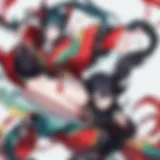In-Depth Analysis of DB Super Broly: Themes and Impact
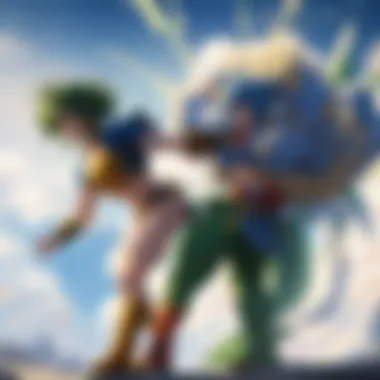

Intro
In the vast realm of anime, few franchises have etched their place in pop culture like Dragon Ball. Since its inception, the series has captivated audiences across generations. With an engaging blend of action, humor, and deep-rooted themes, it managed to become a global phenomenon. The recent movie, DB Super Broly, represents a notable evolution in this storied narrative, bringing forth not just adrenaline-pumping battles but also a rich tapestry of characters and complex stories.
The journey began in the late 1980s with Akira Toriyama’s Dragon Ball manga, which introduced us to Goku, a naive child with extraordinary powers. Fast forward to today, and we see a transformed universe that encapsulates new adventures and timeless characters. The popularity of the series can be attributed to its adventurous spirit and an ever-expanding world. Characters like Vegeta and Goku have become iconic, transcending the medium of anime to influence various facets of entertainment.
Many people might wonder, what is it about DB Super Broly that makes it stand out? This film dives into significant character backstories, particularly focusing on Broly, a character originally introduced in non-canonical films. The prevailing themes of friendship, rivalry, and existential questions resonate strongly with the audience, providing substance beyond mere battles.
At a glance, the film offers a fresh interpretation while honoring the legacy of the Dragon Ball franchise. This comprehensive analysis aims to peel back the layers of DB Super Broly, uncovering its narrative intricacies and profound cultural significance, and why it has garnered both critical acclaim and a dedicated fanbase.
Prelude to DB Super Broly
The significance of DB Super Broly within the broader context of the Dragon Ball franchise cannot be overstated. This film marks a pivotal shift, not only in the storytelling approach but also in how characters are developed and portrayed. The importance of this introduction lies in its exploration of these changes, setting the stage for the detailed discussions that will follow. Understanding the nuances in this movie opens a door to appreciating the evolution of the franchise as a whole.
Overview of the Dragon Ball Franchise
The Dragon Ball franchise is a cornerstone of anime culture, originally created by Akira Toriyama. It encompasses a vast universe filled with dynamic characters, engaging narratives, and a rich tapestry of lore that transcends cultures. Spanning several decades, from the initial manga release in 1984 to the numerous adaptations and films that followed, Dragon Ball has inspired generations.
At its core, the series has consistently focused on the themes of perseverance, friendship, and the eternal struggle between good and evil. Over the years, fans have witnessed the transformation of iconic characters, such as Goku and Vegeta, as they grapple with their powers and responsibilities. The franchise is not merely a series of battles; it’s about personal growth and the connections that form along the way.
Additionally, the franchise has expanded its reach through various media, including movies, video games, and merchandise. Each new installation feels like a breath of fresh air while still honoring the legacy it builds upon. The fusion of nostalgia with modern storytelling techniques introduces new audiences to the magic of Dragon Ball.
Release and Reception of DB Super Broly
DB Super Broly was released in December 2018 in Japan and later made its way into international markets, creating quite the buzz. Upon its release, the film saw a warm reception from both fans and critics, who lauded it for its breathtaking animation and intricate storyline. Its box office performance was notable, being one of the highest-grossing anime films of all time, which reflects its significant impact.
Fans were quick to dive into discussions about the film's fresh perspectives on familiar characters. Broly was reimagined, providing a depth to his character that had previously been unexplored in the earlier cinematic outings. Critics emphasized this new interpretation as a highlight, showing how well DB Super Broly fits into the larger narrative of the series while bringing something novel to the table.
"It is a powerful homage to the roots of the series while pushing the envelope forward in creativity."
In addition to its commercial triumph, DB Super Broly sparked conversations across fan forums and discussion platforms, such as Reddit and Facebook, enabling communities to connect and share their insights on the film.
The blend of nostalgia from the original series and the bold storytelling choices in DB Super Broly resulted in a compelling experience that resonated profoundly with the audience. This strong reception laid a solid foundation for continuing developments in the Dragon Ball narrative, further solidifying the franchise's relevance in contemporary anime culture.
Plot Synopsis and Narrative Structure
The plot synopsis and narrative structure stand as the backbone of any film, providing a roadmap for the audience to navigate through its universe. In the context of DB Super Broly, this segment is vital in unpacking not just the storyline, but also the characterization, themes, and emotional resonance that make this film distinctive within the expansive Dragon Ball franchise. When viewers engage with the movie, understanding these narrative elements enriches their experience and fosters a deeper appreciation of the characters and their journeys.
Setting the Stage: The Background of the Movie
To truly appreciate DB Super Broly, one must first recognize its roots. The film draws extensively from the lore of the Dragon Ball universe, particularly shedding light on the nature of Saiyan history and its intricate relationship with the character Broly. Set in a time of peace following the events of Dragon Ball Super, the film weaves a rich tapestry of past conflicts and familial ties that impact the present narrative.
This backstory does not just serve as a backdrop; it elevates Broly’s character from a mere antagonist into a figure of tremendous complexity. His origin, marked by tragedy and isolation on the desolate planet of Vegeta, compels audiences to empathize with him despite his initial portrayal as a villain. Delving into the socio-political climate of the Saiyans, including the choices made by King Vegeta, nuances the understanding of Broly's plight and the motivations that drive the plot forward.
Main Plot Points and Highlights
As the film unfolds, it presents a series of pivotal plot points that reshape familiar narratives already established in the franchise. The initial conflict revolves around the reintroduction of Broly, who emerges from obscurity to confront Goku and Vegeta, the long-standing heroes of the series. His gradual evolution—from a misunderstood warrior battling the weight of his past to a formidable force in his own right—marks significant turning points in the story.
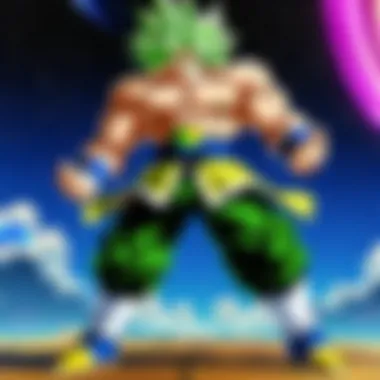

Some key highlights include:
- The Training Montage: Goku and Vegeta’s rigorous training introduces a sense of camaraderie and rivalry typical of shonen genre tales.
- The Frieza Factor: The involvement of Frieza adds a layer of treachery and ambition, setting the stage for a three-way conflict that keeps viewers on the edge of their seats.
- The Reconciliation: In the climax, Broly's struggle shifts as he adapts to his circumstances, forging unexpected alliances that break the traditional hero-villain mold.
This carefully structured plot, underpinned by moments of heart, humor, and tension, encapsulates the essence of a classic Dragon Ball tale while simultaneously paving new paths for character development.
Climactic Moments and Their Significance
The climax of DB Super Broly delivers nail-biting action sequences accompanied by emotional gravity. As the battle reaches its peak, the stakes escalate dramatically, showcasing not only physical prowess but also the importance of friendship and understanding. The encounter between Broly, after harnessing his legendary strength, and Vegeta and Goku symbolizes a climactic convergence of past grievances, potential for forgiveness, and the inherent struggle for identity in a world of chaos.
One standout moment occurs when, in the heat of battle, Broly’s inner turmoil surfaces—a poignant reminder that strength alone does not define a warrior. This moment serves as a reflection on the overarching themes of connectedness and the lengths one will go for those they care about. The emotional resonance of this battle transcends mere spectacle; it marks a turning point in Broly's character arc, highlighting his journey toward acceptance and belonging.
"It's not just about the fight, but what we learn about ourselves and each other through it."
In summary, the plot synopsis and narrative structure of DB Super Broly weave together various elements that contribute to its overall impact. By analyzing the background of the movie, dissecting key plot points, and reflecting on climactic moments, one can appreciate the rich narrative depth that makes this film a standout in the beloved Dragon Ball universe.
Character Dynamics in DB Super Broly
Character dynamics are the lifeblood of any narrative, and in DB Super Broly, they play an especially critical role. The interplay between characters shapes plot direction and influences the emotional landscape of the story. Understanding these dynamics offers a lens through which we can dissect motivations, conflicts, and relationships that meander throughout the film.
Protagonists and Their Development
The protagonists in DB Super Broly—namely Goku, Vegeta, and Broly—are crafted with nuance that showcases their growth and transitions through both challenges and triumphs.
Goku, ever the eager challenger, continues his quest for strength but does so against the backdrop of greater emotional stakes. He interacts with Broly not merely as a competitor but as a mentor figure, recognizing Broly's potential while grappling with the responsibility that comes with it. This shift is markedly different from his previous encounters, demonstrating his evolving narrative.
Vegeta, on the other hand, presents a complex counterpoint to Goku. Initially trapped in a web of rivalry, he gradually comes to terms with his insecurities while embracing Broly as a legitimate force rather than a mere obstacle. The emotional evolution of both characters is palpable and adds layers of depth, illustrating that growth often emerges from recognizing the strengths in others.
Key Protagonist Development Highlights:
- Goku's transformation from a mere fighter to a mentor.
- Vegeta’s gradual acceptance of Broly’s formidable presence.
- The exploration of inner fears and external conflicts as catalysts for growth.
Antagonists: Understanding Broly's Role
Broly serves as a unique antagonist whose complexity challenges traditional notions of villainy. Rather than a straightforward antagonist, he embodies the pain of alienation and the struggle for identity. His backstory, steeped in tragedy and loss, invokes empathy rather than mere animosity.
The structure of Broly's role is innovative; he is not evil for the sake of being evil. Each punch thrown carries with it the weight of his past trauma, making every confrontation with Goku and Vegeta a narrative of catharsis and conflict resolution. Ultimately, Broly's evolution from a raging force to a more humanized character provides a fresh take on antagonism within the franchise.
Important Considerations Regarding Broly:
- Symbolizes trauma and its effects on character behavior.
- Shifts from antagonist to a potential ally represents dynamic storytelling.
- His interactions with Goku and Vegeta provide depth while foreshadowing possible alliances.
"Every character is a universe, and within each universe lies a story waiting to unfold."
Supporting Characters and Their Contributions
The supporting characters in DB Super Broly also play significant roles that bolster the film’s narrative. Characters like Frieza and Paragus add layers to the plot while facilitating the arcs of the main protagonists and antagonist alike.
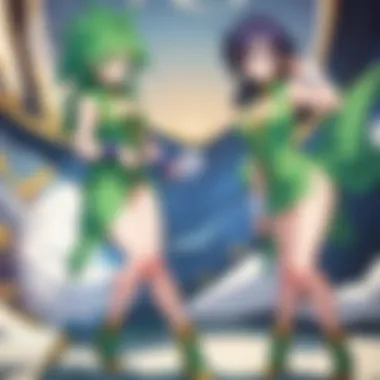

Frieza's role, though villainous, offers a strategic foil to Broly. He manipulates situations, seeking to exploit Broly's strength for his benefit. However, this also serves to further humanize Broly, as it highlights his vulnerability in a world full of manipulation and malice.
Paragus’s relationship with Broly is a poignant aspect that sheds light on themes of control, manipulation, and paternal pressure. His treatment of Broly creates a pathos that carries throughout the film, immersing the audience deeper into Broly's psyche.
Noteworthy Contributions of Supporting Characters:
- Frieza serves as both ally and foe, deepening the tension.
- Paragus represents the darker side of parental influence, complicating Broly’s identity.
- Each supporting character enriches the narrative tapestry, offering critical insights into the main trio’s evolution.
In summary, the character dynamics in DB Super Broly are rich with implications, having far-reaching significance that contributes to both individual and collective character evolution. They drive the narrative forward and enhance audience connection, making this film a vital chapter in the Dragon Ball saga.
Visual and Audio Elements
The visual and audio elements in DB Super Broly are not merely ornamental; they are crucial to the storytelling process. These elements enhance the emotional weight of scenes and deepen audience engagement. In particular, Dragon Ball has always pushed boundaries with its visuals, and DB Super Broly is no exception. The vibrancy of the colors, the fluidity of movements, and the auditory cues all work together to create a mesmerizing experience.
Animation Style and Techniques
When discussing the animation style in DB Super Broly, one can't help but notice the remarkable detail and sophistication that surpasses previous installments. Toriyama's character designs come alive with a vibrant palette and dynamic shading techniques. The fight sequences are nothing short of breathtaking; as characters soar through the air, the animation employs a combination of traditional hand-drawn techniques blended with modern CGI.
This infusion of CG not only ensures fluidity but also allows for complex camera movements that give a grand scale to battles. For a moment, one might feel as if they are in the heat of the fight, thanks to the quick cuts and close-ups that emphasize the intensity of the action. A classic example can be seen when Broly takes flight, showcasing not just his power but also the artistic detail in his furrowed brow, each frame meticulously crafted.
In a medium often marred by overused tropes, DB Super Broly distinguishes itself through its unique approach. Aside from the stunning character modeling, backgrounds play a vital role. The lush landscapes starkly contrast the chaotic battles, breathing life into the setting. Characters are visually distinctive, their designs encapsulating their personalities effectively. For instance, Broly's wild hair and muscular build immediately signal his untamed nature.
Musical Score and Sound Effects
Music in DB Super Broly elevates scenes beyond mere visuals. Composed by the legendary Naoki Sato, the score intricately weaves together traditional orchestral elements and modern soundscapes. Each musical cue serves to amplify emotions, whether it's the haunting strings during Broly's tragic backstory or the thunderous percussion that accompanies climactic battles.
The effective use of silence also deserves attention. In moments of tension, the absence of sound builds anticipation, making even minor sound cues—like the crackle of energy—feel monumental.
Sound effects have undergone an evolution as well. The classic ki blasts and punches resonate more profoundly, reverberating in the viewer's ears long after the credits roll. This auditory mastery contributes to a cohesive experience; one can almost visualize the impact of each blow through sound alone.
"When the music swells and the animation hits its peak, DB Super Broly transcends its medium, inviting viewers into a world where every sound and visual plays a crucial role in storytelling."
Both animation and sound elements are essential for conveying the film's emotional core. They ensure the viewing experience goes beyond aesthetics, creating a narrative tapestry that resonates on multiple levels. This holistic approach to the film’s production is a testament to both the vibrant creativity and dedication of the team behind DB Super Broly. By combining excellent visuals with powerful audio, they manage to craft a film that is not just seen and heard but felt.
Cultural Context and Impact
The cultural context surrounding DB Super Broly is pivotal to understanding the film's reception and relevance within the wider universe of the Dragon Ball franchise. Cultural references serve not just as background filler; they enrich the narrative, adding layers of meaning that resonate with audiences both familiar and new. It's essential to navigate this cultural tapestry as it reveals how the story connects with viewers on a personal level, often reflecting larger societal themes.
In the anime world, DB Super Broly stands as a beacon of not just nostalgia but also progression. Here, traditions clash with modern sensibilities. Themes such as redemption, acceptance, and the complexity of identity are explored through Broly's character. Understanding these elements gives insight into why fans embrace the film, making it a discussion point in both casual conversations and scholarly analysis.
Analysis of Cultural References
DB Super Broly is steeped in cultural references that enhance the richness of its storyline. For instance, Broly's journey showcases themes of alienation and belonging, paralleling struggles faced by individuals in various cultures. Through Broly, the film addresses how familial expectations can shape one's identity, a concept that resonates deeply in many societies where family ties are paramount.
The film also employs visual motifs reminiscent of classic animation styles while using cutting-edge techniques, bridging the old and the new. The nods to Japanese folklore and mythology, such as the classic struggle between good and evil personified through characters like Goku and Vegeta against Broly, reflects deeply embedded cultural narratives. Fans can identify these callbacks, creating a sense of shared experience and nostalgia that enriches their viewing.
Key Cultural Elements:
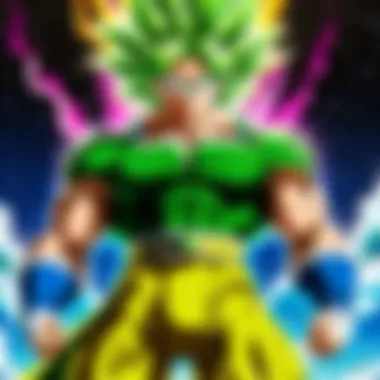

- Familial Dynamics: The complex relationships mirrored in Broly's childhood depict the impact of familial pressure, a theme not uncommon in various narratives across cultures.
- Identity Struggles: Broly's transformation from villain to hero embodies the quest for personal acceptance, a universal struggle laid bare through the lens of anime.
- Traditional vs. Modern: The blend of traditional animation with contemporary storytelling techniques illustrates a cultural evolution, appealing to fans from all walks of life.
"Broly's arc isn’t just about strength; it’s about understanding one’s past and finding a place in a competitive world."
Fan Reception and Community Response
The reception of DB Super Broly within the fandom showcases a vibrant community that continuously engages with the content on multiple levels. Fans often use social media platforms like Reddit and Facebook to express their views, analyze character arcs, and exchange theories. The discussions can run the gamut from the cinematic quality of the animation to the deeper implications of the characters’ motivations.
The film sparked a wave of enthusiasm that carried into various fan-made content, including artwork, fanfiction, and even cosplay. This creative output reflects both admiration and a personal connection to the film's themes. Many fans praise the film for reinvigorating the franchise, sparking debates on the direction of future installments.
Noteworthy Reactions:
- Heightened Interest: The film generated significant buzz leading to its release, with many fans consuming trailers, promotional materials, and interviews with the voice cast.
- Diverse Opinions: Not all reactions were unanimous, as some traditionalists and long-time fans voiced concerns over the film��’s departure from established lore. Yet, these discussions often lead to constructive debates about the franchise's evolution.
- Community-Building: Watch parties and online streams created shared experiences among fans, deepening their connection not only to the film but also to each other.
Comparative Analysis with Previous Installments
In evaluating DB Super Broly, it becomes critical to juxtapose it against earlier entries in the Dragon Ball series. This comparative analysis not only illuminates the evolution of themes and philosophies but also captures a glimpse into character arcs that have shifted across different narratives. By scrutinizing how this film stands as a testament to the growth of the franchise, we can better understand its merit and enduring appeal among fans.
Differences in Themes and Philosophies
When diving into the thematic essence of DB Super Broly, one notices pronounced differences from earlier installments. The notion of identity, especially for Broly, takes center stage, contrasting sharply with the more traditional focus on valor and strength seen in films like Battle of Gods and Resurrection ‘F’. Here, the trauma and tragedy of Broly’s past dictate his actions and motivations, layering complexity on a character who was often seen as a one-dimensional brute in his original appearances.
In this movie, we see the exploration of various themes such as acceptance, the consequences of violence, and the desperate struggle for belonging. For instance, Broly’s upbringing, removed from the world, stands in stark contrast with Goku’s warm family life. This thematic divergence brings a fresh perspective that invites viewers to reflect on how circumstances shape individual identities. In turn, the film challenges the conventional narrative that might suggest that sheer power is the ultimate measure of a hero or villain.
Furthermore, the film highlights relationships in an unprecedented way. While earlier entries often projected a 'me versus you' mentality where clash was the primary driver, DB Super Broly fosters an environment of camaraderie and understanding—even among those who might have once been enemies. This pivot from confrontation to collaboration embodies a mature philosophical approach, offering audiences a richer narrative landscape.
Character Evolution Across the Series
Character development within the Dragon Ball universe has always been a rich tapestry, though DB Super Broly takes it a step further by significantly evolving its roster, particularly with Broly. Originally introduced in Dragon Ball Z: Broly - The Legendary Super Saiyan, Broly's depiction was superficial at best. He was simply a powerhouse, a force of nature without depth. Yet, this iteration affords him an authenticity that makes him relatable and tragic.
Vegeta, often portrayed as the quintessential rival figure, has also undergone substantial evolution. By the time of DB Super Broly, he grapples with his past while navigating newfound responsibilities as a father and protector. These internal conflicts add layers to his character that were often absent in earlier tales, where brute strength often overshadowed emotional depth.
Moreover, Goku, despite being the perennial hero, shows nuances in DB Super Broly. His character exhibits a balance of compassion and strength. This is particularly evident in his interaction with Broly, where he refrains from simply seeing him as a threat, embodying a more understanding and less combative approach.
In essence, DB Super Broly has not only enriched individual character arcs but also laid bare their interconnectedness. This contrast between characters who were once thought to occupy opposing corners of the ring illustrates how far the storytelling framework has come: from simplistic narratives to more sophisticated, intertwining tales of growth and redemption.
"In the grand narrative of Dragon Ball, DB Super Broly stands as a pivotal point, blending the nostalgia of old with the promise of new directions."
Closure
As we draw the curtain on our extensive analysis of DB Super Broly, it becomes clear that the importance of this film within the Dragon Ball franchise and the broader anime landscape cannot be overstated. The narrative weaves complex character arcs with striking visuals and a resonating score, creating an experience that both newcomers and long-time fans can appreciate. By delving into the pivotal aspects of the film, we illuminate its value not only as a standalone story but as a cornerstone of the evolving Dragon Ball universe.
Final Thoughts on DB Super Broly
DB Super Broly offers a robust addition to the saga, particularly through its exploration of themes like identity, friendship, and the consequences of one’s past. Broly's character, marked by deep emotional currents, proves that even the most fearsome figures can possess profound vulnerabilities. Unlike earlier portrayals, this film paints Broly not just as a brute force, but as a complex individual navigating the horrors of his upbringing. The interactions between him, Goku, and Vegeta enrich the narrative, showcasing the importance of understanding and empathy in the face of conflict.
This installment revives interest in legacy characters while expanding upon their motivations and relational dynamics. With humor and heart seamlessly integrated into intense battles, the movie crafts a balanced experience that resonates deeply. The filmmakers did a commendable job in renewing narratives while paying homage to the genuinely beloved aspects of the franchise.
The Future of the Dragon Ball Franchise
Looking ahead, the future of Dragon Ball seems promising. With the film’s success, there’s speculation about continued exploration of character backstories, new arcs, or even different dimensions of existence within the Dragon Ball multiverse. Expect to see emerging storylines that leverage the momentum generated by DB Super Broly. Such developments could serve to more deeply integrate characters previously sidelined or to introduce fresh faces that challenge the status quo.
Moreover, with the rise of international fan engagement—evident on platforms like Reddit.com and Facebook.com—the franchise is seeing a renewed global interest. The community's enthusiasm and discourse can influence its direction, making it a shared journey for fans worldwide.


